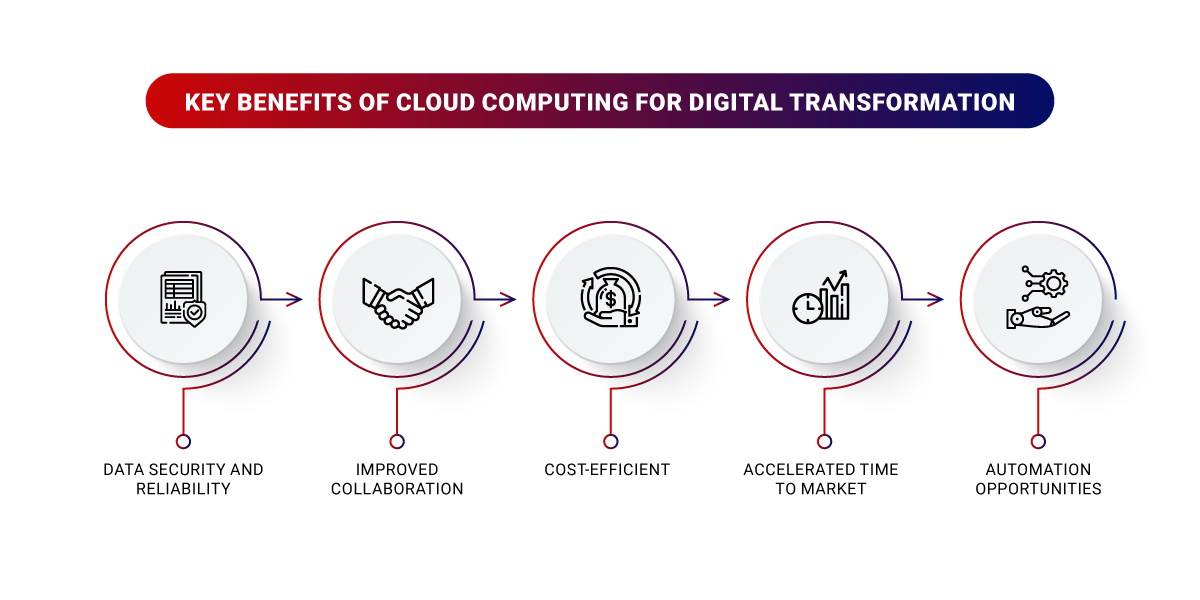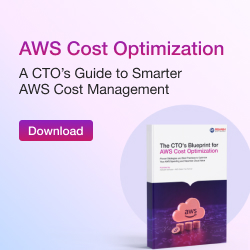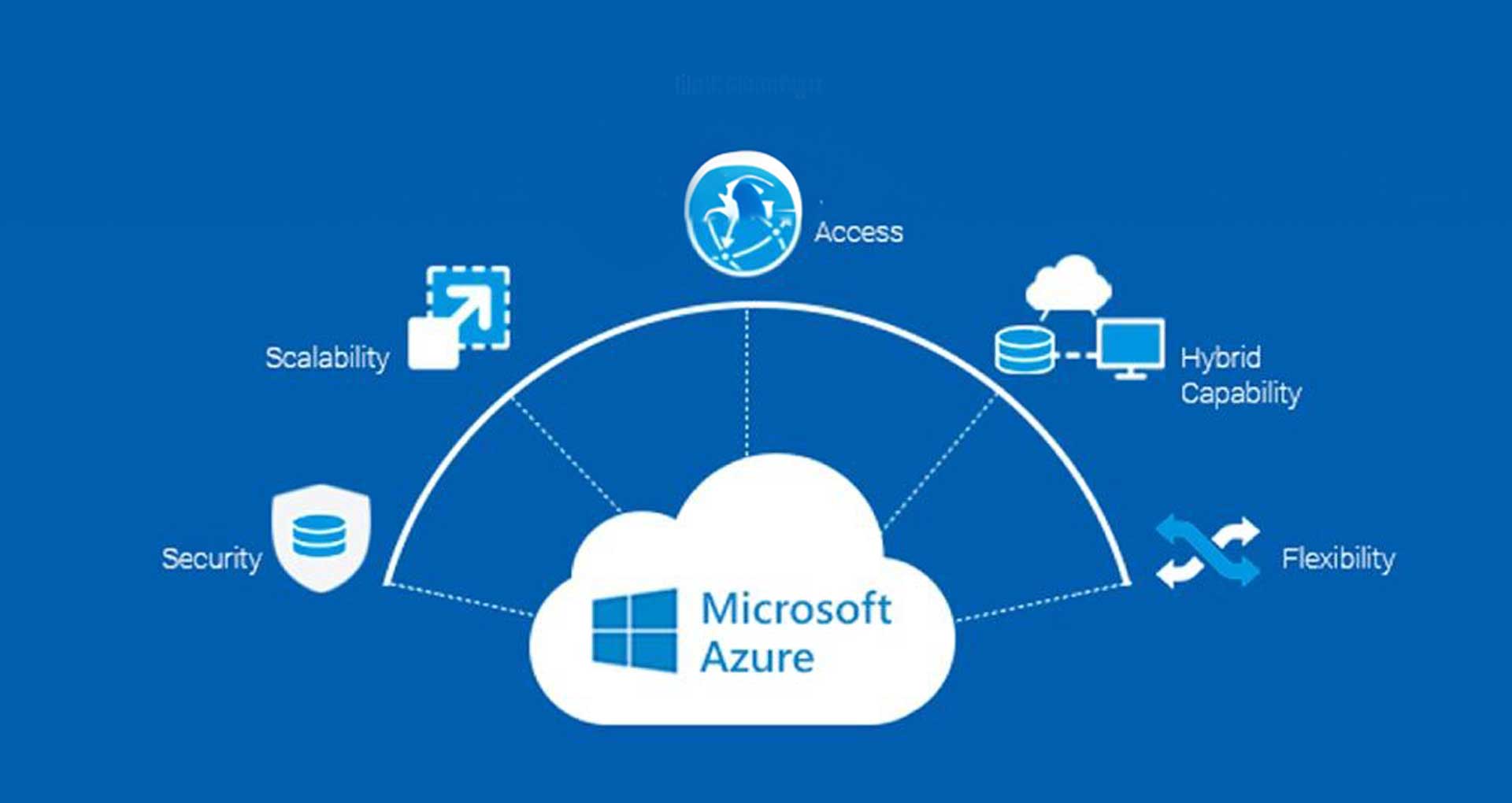Adopting the next big platforms, keeping up with technology trends, and integrating digital solutions into workflows and business processes, today, it’s more than just being part of digital transformation. The digital landscape has evolved. It’s not about simply following the crowd. But, with so many technologies and emerging stacks available, businesses are becoming more intentional. They are starting to truly understand how to leverage these tools, not just for the sake of going digital, but to drive real outcomes across every part of the business.
Among these technologies, cloud computing is making a significant impact and gaining more attention than ever before. In fact, positioning it as a core pillar of digital transformation is not only undeniable but widely accepted. Supporting this shift, the global cloud computing market is projected to grow from USD 781.27 billion in 2025 to USD 2,291.59 billion by 2032. But if you still doubt about cloud computing capabilities in bring digital transformation, keep reading….
In this blog, we’ll explore the benefits and challenges of cloud computing in digital transformation, along with proven approaches and best practices to integrate digital technology into every part of your organization and business strategy.
What Is the Role and Importance of Cloud Computing in Digital Transformation?
Cloud computing plays a crucial role in driving digital transformation, offering businesses the essential flexibility and scalability required for rapid innovation and growth. Let’s explore how cloud computing plays a crucial role in supporting the digital transformation journey:
Agility and Innovation: Since digital transformation is a complex and ongoing process, cloud computing makes it easy for businesses to launch new applications and services during the transformation journey. This agility empowers businesses to experiment with innovative products, services, and experiences as well as expedite their introduction to the market to create value for customers.
Scalability and Cost Efficiency: Cloud is highly scalable, so businesses can easily add or remove resources as needed. This flexibility results in significant reductions in IT expenses, especially when companies are undergoing rapid growth.
Access to Cutting-Edge Technologies: Cloud computing providers present a wide range of advanced technologies, such as AI, ML, and big data analytics. This accessibility empowers businesses to leverage these innovations without substantial investments in their hardware and software.
Enhanced Collaboration: Cloud-based applications and services facilitate effortless collaboration among employees, irrespective of their geographic locations. This collaboration improves overall productivity and efficiency.
Elevated Customer Experience: Cloud computing helps your business gain deeper insights into customer behavior by analyzing vast amount of customer data to enhance customer experience (CX). Cloud-based solutions also enable real-time engagement and omni-channel experience to simplify the delivery of personalized services and support. By enabling your business to streamline customer care processes, cloud computing in digital transformation further makes it easy for businesses to deliver exceptional outcomes to the end-users.
Let’s now explore the many benefits your organization can gain by embracing the cloud for digital transformation.
Major Benefits of Cloud Computing for Digital Transformation
The role of cloud in digital transformation helps businesses with the flexibility to scale resources as and when needed, improves accessibility for remote work, ensures data security, and promotes environmental sustainability. Let’s explore other significant benefits that cloud computing brings to the table:

#1 Data Security and Reliability
Cloud computing focuses more on data security and reliability, making cloud services a trusted choice for businesses. They invest heavily in state-of-the-art security measures and redundancy, going above and beyond what many individual businesses can afford to ensure the safety and availability of data. This comprehensive approach to data security not only safeguards critical business information but also significantly enhances the reliability and business continuity of operations.
Example:
Consider a global e-commerce company that relies on the cloud to store and manage customer data, product information, and transaction records. The company uses a leading cloud provider renowned for its security infrastructure. Here’s how this benefit of data security and reliability plays out:
- Robust Security Measures: The cloud provider employs advanced encryption, multi-factor authentication, intrusion detection systems, and constant security monitoring. In practice, this means that even in the event of a cyberattack or data breach attempt, customer and transaction data remain protected.
- Data Redundancy: Cloud providers often maintain multiple data centers across different geographic locations. This redundancy ensures that in the rare event of a hardware failure, natural disaster, or other unexpected disruptions, data remains accessible and secure.
- Reliability and Business Continuity: In the event of a server failure or power outage, the system automatically switches to an alternate data center without any noticeable service interruption, ensuring business continuity. The e-commerce company can confidently operate, knowing that its online store will remain available to customers 24/7.
- Cost Savings: By leveraging the cloud provider’s robust security and reliability features, the e-commerce company avoids the substantial costs of building and maintaining its data security infrastructure and disaster recovery solutions.
#2 Improved Collaboration
Cloud computing in digital transformation is a revolutionary technology for enhancing collaboration within and outside an organization. It enables seamless access and sharing of data and applications across devices and departments.
Key Aspects of Cloud Computing for Improved Collaboration:
- Seamless Data Sharing
- Accessibility Across Devices
- Real-time Communication
- Remote Work Enablement
#3 Cost-Efficient
By moving your IT infrastructure to the cloud, you can eliminate the expenses of purchasing and maintaining on-premises hardware and software. Also, cloud service providers offer various pricing options, such as spot and reserved instances, allowing companies to optimize their cloud costs. Around 82%[1] of small and medium businesses report reduced costs after adopting cloud tech. This cost efficiency enables businesses to allocate resources more effectively and invest in other critical areas of growth and development.
#4 Accelerated Time to Market
In the conventional approach, it took a lot of work to set up and manage the IT infrastructure for new projects, which involved significant time and capital investment. This acts as a barrier to quick innovation. Cloud service providers offer a solution to this problem by providing pre-configured services to fulfil all your business needs.
Cloud Computing enables the organization to access servers, databases, and other necessary components within minutes. This helps reduce the time to market and increases agility, allowing businesses to stay ahead of market demands.
#5 Automation Opportunities
Cloud computing in digital transformation provides various automation advantages that enhance efficiency, agility, and cost-effectiveness in multiple areas of a business’s operations.
By leveraging cloud services, businesses can automate routine, time-consuming tasks, reducing the risk of human error and reducing human intervention for more strategic outcomes. This not only improves operational efficiency but also enhances overall productivity. Whether it be scaling the infrastructure, continuous compliance monitoring, or managing automated back-ups, cloud computing offers tremendous automation capabilities to organizations.
Some specific examples of cloud-based automation
- Infrastructure Scaling and Management: Cloud platforms provide auto-scaling features, allowing businesses to adjust their computing resources based on demand.
- Security and Compliance Monitoring: Cloud computing and digital transformation provide automated security and compliance monitoring solutions to identify and react to security threats, vulnerabilities, and compliance concerns in real-time.
- Data Backup and Disaster Recovery: Businesses can protect their essential data and systems by configuring automated backup schedules and disaster recovery plans.
- Resource Optimization: Cloud automation tools can continuously monitor resource usage and make recommendations or adjustments to optimize resource allocation.
- Workflow and Process Automation: Beyond infrastructure and IT operations, cloud platforms offer tools for automating business workflows and processes. This includes order processing, document approval, and customer support ticket routing.
Cloud Computing Challenges in Digital Transformation and How to Overcome Them
As you know, cloud computing has accrued benefits for digital transformation. However, its adoption also presents several challenges, including security concerns, skill shortages, and cost management.
Let us explore the most common cloud computing challenges in digital transformation and practical solutions for overcoming them. By understanding these challenges and how to address them, businesses can ensure that their cloud computing and digital transformation initiatives are successful and deliver the desired results.

Security Concerns
Keeping data and systems secure in cloud computing is a big challenge because cloud providers share their infrastructure and resources with multiple customers. In the event of a security vulnerability within the cloud provider’s infrastructure, it exposes all of its customers to potential risks such as malware attacks, and data breaches.
Solution:
You should prioritize security by implementing security controls and monitoring your cloud environment for vulnerabilities. Use encryption, access controls, and regular security audits to protect your data. Employing strong passwords and multi-factor authentication are among the best practices to enhance your cloud security.
Data Privacy and Compliance
No cloud providers can guarantee 100% data privacy. Cloud providers store and process data in remote locations, making it difficult for organizations to control their data and ensure compliance with applicable regulations.
Solution:
To address this challenge:
- Familiarize yourself with the relevant data protection laws such as GDPR or HIPAA.
- Choose cloud service providers that offer compliance features and tools.
- Regularly audit and update your compliance measures to stay on the right side of the law.
- Have a business contingency plan in place for responding to data privacy and compliance incidents.
Cost Management
Cloud computing can become expensive if not managed properly. Organizations face unexpected costs due to data transfer, storage, or overprovisioned resource costs, especially in complex multi-cloud environments. It can further vary depending on usage, performance, availability, location, and features.
Solution:
To tackle this challenge:
- Use cloud cost management tools such as CloudWatch by AWS, Cloud Health, and similiar to track and control expenses.
- Implement auto-scaling to adjust resources based on demand.
- Regularly review your cloud usage to identify areas where you can cut costs.
- Implement cloud governance policies and procedures, such as policies to prevent overprovisioning and unexpected costs.
Explore our AWS cost optimization eBook to control spend and reduce cloud surprises.
Integration Complexity
Integrating legacy systems with cloud-based solutions can be complicated, leading to disruptions in business operations. Some specific integration complexity challenges include heterogeneous cloud applications and services, API complexity, frequent changes in cloud applications and services, and lack of expertise to integrate existing on-premises systems.
Solution:
To overcome this challenge, develop a comprehensive cloud integration strategy and choose the right approach. Consider using middleware or APIs to bridge the gap between old and new systems. Test integrations thoroughly to ensure a smooth transition.
Data Migration
Moving existing data and applications to the cloud can be challenging, with potential data loss or downtime during the migration process. Moreover, the entire migration process is intricate, time-intensive, and financially demanding.
Solution:
Plan your data migration carefully by understanding the migration needs. There are several data migration strategies available (such as lift-and-shift, re-platforming, and refactoring) and you can choose the right one according to your requirements. It is a good business practice to back up your data, perform test migrations, and have a rollback strategy in case of issues. You may also engage with experts or cloud migration services to ensure a successful transition.
Multi-cloud complexity
Handling multiple cloud environments can be challenging, especially when dealing with various cloud providers. Each provider comes with its own set of tools, APIs, and billing structures, which can complicate obtaining a unified overview of your cloud expenditures and usage. These create complexity and challenges for organizations.
Solution:
Using a cloud management platform will help you manage multiple cloud environments proficiently. Execute cloud governance policies and procedures to ensure that your multi-cloud environment is managed effectively.
Top Strategies for Cloud Adoption in Digital Transformation
By now you can relate to how cloud and digital transformation helps modern businesses realign business process. However, you need an effective business strategy that focuses on key components – the organization’s goals, current structure, and processes – much needed to make the “right” shift towards optimization. Cloud Integration Services can be a strong support for this major shift by connecting systems and processes.
let’s explore the key strategies for cloud adoption in digital transformation.
- Technology Selection: Collaborating closely with a cloud enablement partner empowers you to define the technologies needed to meet your unique requirements precisely. A critical component of this process involves identifying legacy technologies that could hinder your progress toward overall growth.
- Data Requirement Analysis: A detailed examination of data systems would reveal the right input about current data, identify substandard data types and remove unnecessary or unused data. Outlining a plan to audit current data and building a knowledge base of the new data type is something your technology partner can offer before combining them for the shift.
- Process Mapping: The most crucial yet difficult part of any digital transformation strategy – the business process must focus on how to realign resources & operations to serve customers better. Further, these decisions must be made in favor of changes with the digital interface that ultimately serves the customer well.
- Organizational Alignment: This step primarily deals with the mindset to accept and embrace digital transformation across the organization. With dedicated IT representatives & employees well-versed in explaining the new processes, change management can be dealt with swiftly. The objective here is to help ease the organizational changes in nearly every aspect of business after transformation.
What Are The 4 Types of Service Models in Cloud Computing?
While we’ve discussed the key components of strategy, let us now explore the different types of cloud computing that could enable digital transformation with cloud. There exist four types of cloud computing service models.
Software as a Service (SaaS)
- Offered on-demand, it uses the internet to deliver third-party managed applications to avoid download needs by clients or businesses.
- Third-party cloud provider hosts software apps and provide them on-demand across the globe.
Infrastructure as a Service (IaaS)
- A comprehensive cloud computing service model, it offers IT infrastructure services like software, hardware, databases and platforms with network, processing power, storage, and servers.
- Allows application development by purchasing resources on-demand with the evolving computing needs.
Platform as a Service (PaaS)
- Allows company’s software developers to create and manage custom applications.
- Third-party vendors can manage IT infrastructure and access to computing resources (servers, storage, security, integration layers, network components, & more)
Functions as a Service (FaaS)
- It enables developers to run individual functions without having to manage the underlying infrastructure, offering a cost-effective and scalable approach.
- FaaS is ideal for applications that require rapid, event-driven processing and can be a valuable addition to your cloud toolkit for specific use cases.
Best Practices for Cloud Computing in Digital Transformation
With the cloud, organizations can innovate more quickly, scale efficiently, innovate more easily and seize new market capabilities faster. All this, while also reducing technology risk. To maximize the benefits of cloud computing in digital transformation, organizations must adopt these best practices.
Define a Clear Cloud Strategy and Roadmap
Before embarking on your digital transformation and cloud computing journey, establish a well-defined strategy and roadmap. This includes setting clear goals, aligning with business strategy, and understanding customer needs. The roadmap should outline the steps, timelines, and milestones for implementation while assessing the current desired future state and any associated risks.
Choose the Right Cloud Model and Service
Selecting the most suitable cloud deployment model is critical. Businesses can select from public, private, or hybrid cloud models according to their specific needs and comfort level with risk. There are four types of cloud service models.
1) IaaS 2) PaaS 3) SaaS 4) FaaS
While IaaS supplies fundamental computing resources, PaaS offers development environments, SaaS delivers ready-to-use applications, and Functions as a Service FaaS enables developers to run individual functions with a cost-effective approach.
Evaluate existing applications and workloads to determine their suitability for cloud migration. Some may require re-architecting or refactoring for optimization, while others might need retirement or replacement. Plan and execute the migration process carefully, considering approaches such as lift-and-shift, re-platforming, re-hosting, re-purchasing, or re-building to ensure a smooth, secure, and efficient transition.
Develop and Deploy Cloud-Native Applications
For enterprise digital transformation and cloud adoption, create and deploy cloud-native applications explicitly designed for the cloud. These software solutions are agile, scalable, and resilient, using microservices, containers, serverless architecture, DevOps, and continuous integration and delivery (CI/CD) practices. They integrate effortlessly with cloud-based and on-premises applications and data stores, enriching flexibility and enabling innovation.
Manage and Monitor Cloud Resources and Performance
Ongoing management and monitoring of cloud resources are crucial to ensure availability, reliability, and security. Automation and orchestration of resource provisioning and management are essential, along with regular performance and cost monitoring. Utilize tools and frameworks for visibility, control, and optimization of cloud operations.
Implement a Cloud Governance and Security Framework
Establish a governance and security framework that defines policies, standards, and best practices for cloud adoption and usage. This framework should encompass data protection, identity and access management, compliance, incident management, and business continuity planning. The alignment with business objectives and compliance with legal requirements is paramount.
Foster a Cloud Culture and Mindset
Instil a cloud-centric culture within your organization, emphasizing change, innovation, and collaboration. Effective communication about the benefits and challenges of digital transformation and cloud adoption across the organization is critical. Engage and empower employees, customers, and partners with support and guidance, and establish mechanisms for measuring and rewarding the outcomes and learnings of cloud adoption.
How Rishabh Software Can Help You Unlock the Potential of Cloud in Digital Transformation?
Rishabh Software is your trusted cloud application development partner that can help you unlock the true potential of the cloud in digital transformation by helping you develop a strategic approach. Our cloud consulting experts are proficient in facilitating the deployment of your cloud applications in various environments, be it public, private, hybrid, or multi-cloud.
Our expertise lies in cloud solutions, hybrid cloud consulting, application modernization, and data analytics services to help you grow your business at the pace of evolving customer needs. Our team, with the right mix of extensive experience and knowledge of technologies, can deliver projects of any scale to increase business agility.
Frequently Asked Questions
Q: What is a cloud-first strategy in digital transformation?
A: A cloud-first strategy is where organizations prioritize using cloud computing for digital transformation as a foundational technology over traditional on-premises systems for their digital initiatives. This approach involves choosing cloud-based solutions when creating new applications, platforms, and infrastructure. A cloud-first strategy provides several benefits to the organization, such as scalability, flexibility, cost-efficiency, agility, disaster recovery, and many more.
Q: Real World Examples of Cloud enabled digital transformation?
- Netflix – Migrated to AWS to enable global streaming, AI-driven recommendations, and scalability.
- Airbnb – Uses AWS for scalable operations, dynamic resource allocation, and global service delivery.
- Coca-Cola – Adopted cloud solutions for real-time supply chain and bottling process optimization.
- Unilever – Moved infrastructure to AWS for unified data analytics and faster consumer insights.
Footnotes:












 30 Min
30 Min


